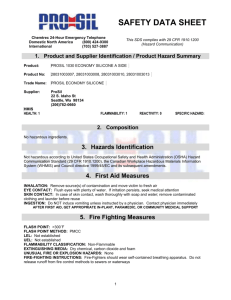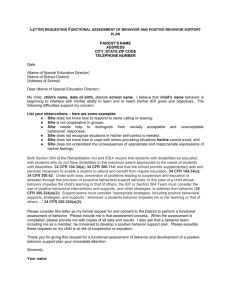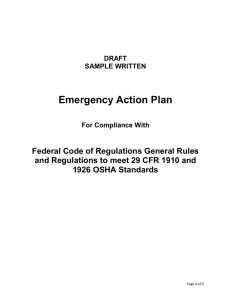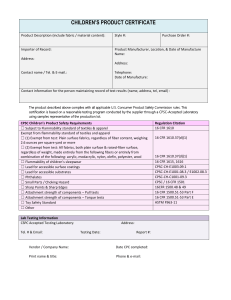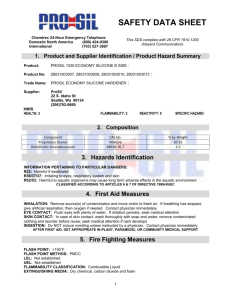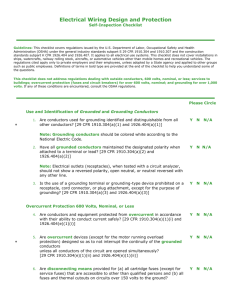Electrical Components and Equipment
advertisement
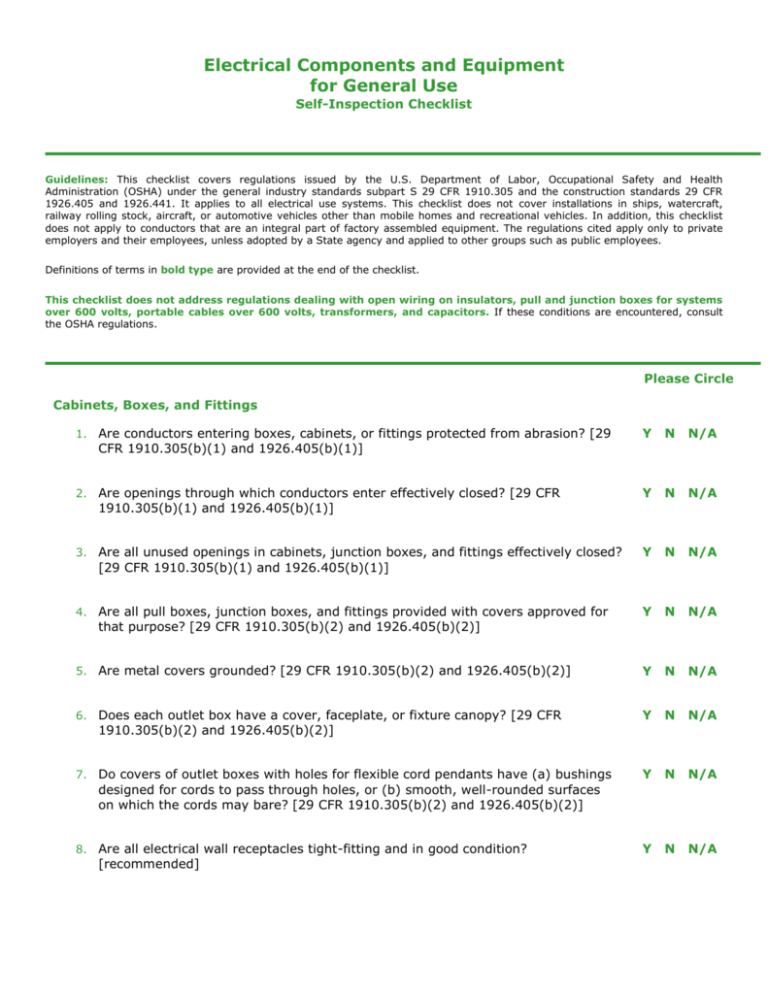
Electrical Components and Equipment for General Use Self-Inspection Checklist Guidelines: This checklist covers regulations issued by the U.S. Department of Labor, Occupational Safety and Health Administration (OSHA) under the general industry standards subpart S 29 CFR 1910.305 and the construction standards 29 CFR 1926.405 and 1926.441. It applies to all electrical use systems. This checklist does not cover installations in ships, watercraft, railway rolling stock, aircraft, or automotive vehicles other than mobile homes and recreational vehicles. In addition, this checklist does not apply to conductors that are an integral part of factory assembled equipment. The regulations cited apply only to private employers and their employees, unless adopted by a State agency and applied to other groups such as public employees. Definitions of terms in bold type are provided at the end of the checklist. This checklist does not address regulations dealing with open wiring on insulators, pull and junction boxes for systems over 600 volts, portable cables over 600 volts, transformers, and capacitors. If these conditions are encountered, consult the OSHA regulations. Please Circle Cabinets, Boxes, and Fittings 1. Are conductors entering boxes, cabinets, or fittings protected from abrasion? [29 Y N N/A 2. Are openings through which conductors enter effectively closed? [29 CFR Y N N/A Y N N/A 4. Are all pull boxes, junction boxes, and fittings provided with covers approved for Y N N/A 5. Are metal covers grounded? [29 CFR 1910.305(b)(2) and 1926.405(b)(2)] Y N N/A 6. Does each outlet box have a cover, faceplate, or fixture canopy? [29 CFR Y N N/A 7. Do covers of outlet boxes with holes for flexible cord pendants have (a) bushings Y N N/A Y N N/A CFR 1910.305(b)(1) and 1926.405(b)(1)] 1910.305(b)(1) and 1926.405(b)(1)] 3. Are all unused openings in cabinets, junction boxes, and fittings effectively closed? [29 CFR 1910.305(b)(1) and 1926.405(b)(1)] that purpose? [29 CFR 1910.305(b)(2) and 1926.405(b)(2)] 1910.305(b)(2) and 1926.405(b)(2)] designed for cords to pass through holes, or (b) smooth, well-rounded surfaces on which the cords may bare? [29 CFR 1910.305(b)(2) and 1926.405(b)(2)] 8. Are all electrical wall receptacles tight-fitting and in good condition? [recommended] Switches 9. Are single-throw knife switches connected so that the blades are dead when the Y N N/A Y N N/A Y N N/A Y N N/A Y N N/A Y N N/A 15. Are switches, circuit breakers, and switchboards installed in wet locations enclosed Y N N/A 16. Is water leakage into light receptacles or fixtures (which may cause a fire hazard) Y N N/A 17. Are all conductors used for general wiring insulated? [29 CFR 1910.305(f) and Y N N/A 18. Is the insulation approved for the voltage, operating temperature, and location of Y N N/A Y N N/A switch is in the open position? [29 CFR 1910.305(c)(1) and 1926.405(c)] Note: These types of switches should be accessible only to qualified persons. 10. Are single-throw knife switches placed so that gravity will not cause them to close? [29 CFR 1910.305(c)(1) and 1926.405(c)] 11. Do single-throw knife switches approved for use in the inverted position have a locking device that will keep the blades in the open position when so set? [29 CFR 1910.305(c)(1) and 1926.405(c)] Do flush snap switches that are mounted in ungrounded metal boxes and located within reach of conducting surfaces have face plates of nonconducting, noncombustible material? [29 CFR 1910.305(c)(2)] Note: Light switches need a cover plate. Switchboards and Panelboards 13. Are panelboards mounted in cabinets, cutout boxes, or enclosures approved for the purpose and of the dead front type? [29 CFR 1910.305(d) and 1926.405(d)] Enclosures for Damp Locations 14. Are cabinets, cutout boxes, fittings, boxes, and panelboard enclosures in damp locations installed so as to prevent moisture from accumulating within the enclosures? [29 CFR 1910.305(e)(1) and 1926.405(e)(1)] in weatherproof enclosures? [29 CFR 1910.305(e)(2) and 1926.405(e)(2)] immediately repaired? [recommended] (Look for evidence of water leakage.) Conductors for General Wiring 1926.405(f)] use? [29 CFR 1910.305(f) and 1926.405(f)] 19. Is the insulated conductor distinguished by color or other suitable means as being the grounded conductor, ungrounded conductor, or equipment grounding conductors? [29 CFR 1910.305(f) and 1926.405(f)] Flexible Cords and Cables 20. Are flexible cords and cables prohibited from being used as a substitute for fixed Y N N/A 21. Are flexible cords used only in continuous lengths without splices or tap? Y N N/A 22. Are flexible cords connected to devices and fittings so strain relief is provided to Y N N/A Y N N/A Y N N/A Y N N/A Y N N/A wiring of a structure where they are (a) attached to building surfaces; (b) concealed; (c) run through holes in walls, ceilings, or floors; or (d) run through doorways, windows, or similar openings? [29 CFR 1910.305(g)(1)(iii) and 1926.405(g)(1)(iii)] Note: Flexible cords and cables may be used only for the following: pendants; wiring of fixtures; connecting portable lamps or appliances; elevator cables; wiring cranes and hoists; connecting stationary equipment to facilitate their frequent interchange; preventing the transmission of noise or vibration; appliances that have fastening means and mechanical connections that can be removed for maintenance and repair; or data processing cables approved as a part of the data processing system.[29 CFR 1910.405(g)(1)(i) [29 CFR 1910.305(g)(2)(ii) and 1926.405(g)(2)(iii)] prevent pull from being directly transmitted to joints or terminal screws? [29 CFR 1910.305(g)(2)(iii) and 1926.405(g)(2)(iv)] 23. Are all wires located away from walking areas to prevent a tripping hazard? [recommended] Note: Flexible cords used by labs or shops for portable equipment are recommended to be designed for hard or extra hard usage. Equipment for General Use: Lighting Fixtures, Lampholders, Lamps, and Receptacles 24. Are fixtures, lamp holders, lamps, rosettes, and receptacles designed and maintained so that no live parts can expose employees to contact? [29 CFR 1910.305(j)(1)(i) and 1926.405(j)(1)(i)] 25. Are portable hand lamps supplied through flexible cords equipped with a handle of molded composition or other approved material and a substantial guard attached to the lamp holder or handle? [29 CFR 1910.305(j)(1)(ii) and 1926.405(j)(1)(iii)] 26. Is the use of multiple plug receptacles prohibited? [recommended] Equipment for General Use: Receptacles, Cord Connectors, and Attachment Plugs (caps) 27. Are receptacles, cord connectors, and attachment plugs constructed so that Y N N/A Y N N/A receptacles or cord connectors will accept only an attachment plug with a voltage or current rating for which the device is intended? [29 CFR 1910.305(j)(2)(i) and 1926.405(j)(2)(i)] 28. Are receptacles installed in damp locations suitable for that location? [29 CFR 1910.305(j)(2)(ii) and 1926.405(j)(2)(ii)] Note: Ground-fault circuit interrupters are recommended in these types of locations. Equipment for General Use: Appliances 29. Are appliances designed and maintained so that they have no live parts normally Y N N/A 30. Are means provided to disconnect each appliance? [29 CFR 1910.305(j)(3)(ii) and Y N N/A 31. Is each appliance marked with its rating in volts and amperes or volts and watts? Y N N/A 32. Are electrical appliances in good operational condition? [recommended] Y N N/A Y N N/A Y N N/A Y N N/A Y N N/A Y N N/A exposed to employee contact? [29 CFR 1910.305(j)(3)(i) and 1926.405(j)(3)(i)] 1926.405(j)(3)(ii)] [29 CFR 1910.305(j)(3)(iii) and 1926.405(j)(3)(iii)] Equipment for General Use: Motors 33. Is the disconnecting means within view from the controller? [29 CFR 1910.305(j)(4)(ii)(A) and 1926.405(j)(4)(ii)(A)] Note: If a motor and the driven machinery are not within view from the controller location, consult OSHA regulations. 34. Does the disconnecting means disconnect the motor and the controller from all * ungrounded supply conductors, and is it designed so that no pole can be operated independently? [29 CFR 1910.305(j)(4)(ii)(B) and 1926.405(j)(4)(ii)(B)] 35. Are motors, motor control apparatus, and motor branch- circuit conductors * protected against overheating from motor overload or failure to start, and against short-circuits or ground faults? [29 CFR 1910.305(j)(4)(iii) and 1926.405(j)(4)(iii)] 36. Are exposed live parts of motors and controllers operating at 50 volts or more between terminals guarded against contact? [29 CFR 1910.305(j)(4)(iv)(A) and 1926.405(j)(4)(iv)(A)] Storage Batteries 37. Is sufficient diffusion and ventilation provided to storage batteries to prevent the accumulation of explosive mixtures? [29 CFR 1910.305(j)(7) and 1926.441(a)(1)and(2)] Definitions: Controller: a device or group of devices that governs, in a predetermined manner, the electric power delivered to the apparatus to which it is connected. Cutout box: an enclosure designed for surface mounting with swinging doors or covers secured directly to and telescoping with the walls of the box. Dead front: without live parts exposed to a person on the operating side of the equipment. Panelboard: a single or group of panel units designed for assembly in the form of a single panel. The panelboard includes buses and automatic overcurrent devices, and may or may not have switches to control light, heat, or power circuits. It is designed to be placed in a cabinet or cutout box in or against a wall and accessible only from the front.

